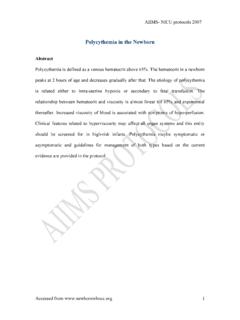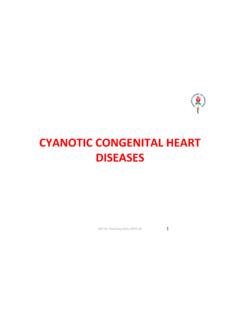Transcription of ABM Clinical Protocol #1: Guidelines for Blood …
1 BREASTFEEDING MEDICINE. Volume 9, Number 4, 2014 ABM Protocol Mary Ann Liebert, Inc. DOI: ABM Clinical Protocol #1: Guidelines for Blood Glucose Monitoring and Treatment of Hypoglycemia in Term and Late-Preterm neonates , Revised 2014. Nancy Wight,1,2 Kathleen A. Marinelli,3,4 and The Academy of Breastfeeding Medicine A central goal of The Academy of Breastfeeding Medicine is the development of Clinical protocols for managing common medical problems that may impact breastfeeding success. These protocols serve only as Guidelines for the care of breastfeeding mothers and infants and do not delineate an exclusive course of treatment or serve as standards of medical care.
2 Variations in treatment may be appropriate according to the needs of an individual patient. Purpose Blood glucose concentrations do develop secondary to pro- longed intervals (> 8 hours) between breastfeeding, a marked T o provide guidance in the first hours/days of life to: ketogenic response occurs. The enhanced capability of the neonatal brain to utilize ketone bodies provides glucose-sparing Prevent clinically significant hypoglycemia in infants fuel to the brain, protecting neurological ,7 9 The Appropriately monitor Blood glucose levels in at-risk compensatory provision of alternate fuels constitutes a normal term and late-preterm infants adaptive response to transiently low nutrient intake during the Manage documented hypoglycemia in infants establishment of breastfeeding,3.
3 10 resulting in most breastfed Establish and preserve maternal milk supply during infants tolerating lower plasma glucose levels without any sig- medically necessary supplementation for hypoglycemia nificant Clinical manifestations or or during separation of mother and baby No studies have shown that treating transiently low Blood glucose levels results in better short-term or long-term outcomes Background compared with no treatment, and in fact there is no evidence at all that hypoglycemic infants with no Clinical signs benefit from Physiology ,12 Increases in neurodevelopmental abnormalities The term hypoglycemia'' refers to a low Blood glucose have been found in infants who have hypoglycemia associated concentration.
4 Clinically significant neonatal hypoglycemia with abnormal Clinical signs, especially those with severe, per- reflects an imbalance between the supply and utilization of sistent hyperinsulinemic 16 Rozance and glucose and alternative fuels and may result from several dis- Hay17 have delineated the conditions that should be present turbed regulatory Transient hypoglycemia in the before considering that long-term neurologic impairment might first hours after birth is common, occurring in almost all mam- be related to neonatal hypoglycemia. Transient, single, brief malian newborns.
5 In healthy, term human infants, even if early periods of hypoglycemia are unlikely to cause permanent enteral feeding is withheld, this phenomenon is self-limited, neurologic 21 Therefore, the monitoring of Blood without Clinical signs, and considered to be part of adaptation to glucose concentrations in healthy, term, appropriately grown postnatallife,asglucoselevelsspontaneous lyrisewithinthefirst neonates is unnecessary and potentially harmful to parental well- 24 hours after birth (for some, it is even longer but still physio- being and the successful establishment of 23.)
6 Logical).2 6 Most neonates compensate for this physiological''. Definition of hypoglycemia low Blood glucose with endogenous fuel production through gluconeogenesis, glycogenolysis, and ketogenesis, collectively The definition of hypoglycemia in the newborn infant called counter-regulation.'' Eveninthose situationswhere low has remained controversial because of a lack of significant 1. San Diego Neonatology, Inc., San Diego, California. 2. Sharp HealthCare Lactation Services, Sharp Mary Birch Hospital for Women and Newborns, San Diego, California.
7 3. Division of Neonatology and The Connecticut Human Milk Research Center, Connecticut Children's Medical Center, Hartford, Connecticut. 4. University of Connecticut School of Medicine, Farmington, Connecticut. 173. 174 ABM Protocol . Table 1. Population Low Thresholds: vidual patient. Rather, it is characterized by a value(s) that is Plasma Glucose Level40 unique to each individual and varies with both their state of physiologic maturity and the influence of pathology Hour(s) after 5th percentile plasma birth glucose level A meta-analysis of studies published from 1986 to 1994.
8 1 2 (nadir) 28 mg/dL ( mmol/L) looked at low plasma glucose thresholds in term healthy 3 47 40 mg/dL ( ) newborns who were mostly mixed fed (breastfed and for- 48 72 48 mg/dL ( mmol/L) mula-fed) or formula-fed. It presented statistical ranges of low thresholds for plasma glucose level based on hours after birth in healthy term infants (Table 1).40 The authors spe- correlation among plasma glucose concentration, Clinical cifically noted that given the known lower plasma glu- signs, and long-term ,24,25 An expert panel con- cose levels in healthy term breastfed infants as compared vened in 2008 by the National Institutes of Health with formula-fed infants, the low thresholds for exclusively concluded that there has been no substantial evidence-based breastfed infants might even be lower.
9 Table 1 gives rec- progress in defining what constitutes clinically important ommendations for this timed threshold approach. neonatal hypoglycemia, particularly regarding how it relates This information is translated into Guidelines for Clinical in- to brain Multiple reviews have concluded that there tervention by the operational treatment guidance of Cornblath is no specific plasma or Blood glucose concentration or du- et As they stated, an operational threshold is that concen- ration of low Blood glucose level that can be linked to either tration of plasma or whole Blood glucose at which clinicians Clinical signs or permanent neurologic ,25.
10 27 In ad- should consider intervention, based on the evidence currently dition, Blood glucose test results vary enormously with the available in the literature (Table 2). It needs to be underscored source of the Blood sample, the assay method, and whether that the therapeutic objective (45 mg/dL [ mmol/L]) is dif- whole Blood , plasma, or serum glucose concentration is de- ferent from the operational threshold for intervention (36 mg/dL. termined. Plasma or serum glucose concentrations are 10 15% [ mmol/L]), which is different from the population low higher than in whole ,29 thresholds in normal babies with no Clinical signs or risk Breastfed, formula-fed, and mixed-fed infants follow the factors who do not need to be treated (Table 1).



